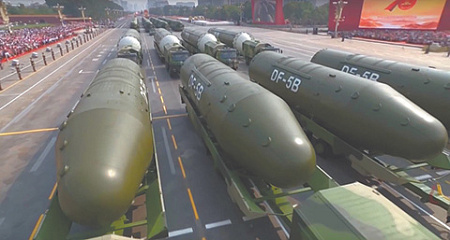
For the first time, Chinese TV revealed information about the DF-5 missile, an important component in the strategy of deterring a potential enemy. A ballistic missile with a range of up to 13,000 km is capable of carrying nuclear charges. Previously, Beijing tried to keep information about its nuclear power completely closed to the outside world. But now the approach has changed. Given the lessons of the Ukrainian crisis, China has decided to warn the United States and its allies that they could be dealt a crushing blow if they try to prevent Taiwan’s reunification with their homeland or attack Chinese-owned islands and shoals in the South China Sea.
The leadership of the Chinese Communist Party does not want its compatriots and foreigners to consider it weak and indecisive. Therefore, official statements transmitted via the Internet or at briefings often sound harsh and uncompromising. Analysts working in the West or East Asia are used to this. They are able to decipher formulations that would seem like a sealed commandment to an ordinary reader or, conversely, primitive propaganda.
But this time Beijing decided not to limit itself to loud statements. He slightly lifted the veil of secrecy over his nuclear arsenal. At least over the kind of weapon that is capable of hitting the enemy anywhere in the world. This is the DF-5 rocket, or in Chinese – “Dong Feng” (“East Wind”). The title is taken from a saying by Mao Zedong, who once wrote: “The east wind has suppressed the west wind.”
What exactly is the DF-5? It is a land-based intercontinental ballistic missile. Two-stage. The warhead is separable, contains 10 parts, which are individually guided. Each part can carry a nuclear charge.
In an interview with NG, Vasily Kashin, a senior researcher at the Higher School of Economics, noted: “Previously, China’s nuclear policy in terms of information was structured in such a way as to attract as little attention to it as possible. China has done something in this area, but has stressed that this is only a necessary minimum compared to what Russia and the United States have. The fact that Beijing has now decided to talk about this at the state media level indicates a change in approach to covering nuclear policy. This liquid-fueled missile is capable of striking the United States. Its basic version was created in the early 1970s, and began to enter service in the early 1980s. A rocket was created on the basis of Dong Feng, on which the Chinese manned program is being implemented.”
According to the expert, the first DF-5s were quite primitive. The DF-5 was supposed to be refueled for two hours before launch. She was difficult to maintain. Then a more advanced rocket was created, which was called the DF-5a. And in the early 2010s, the DF-5b was created, which differed radically from its predecessors. In addition to the separable individual guidance head, that is, the ability to carry multiple warheads, there is a digital control system. Amputation (from the word ampoule) of the fuel tanks was carried out. This is a technology that allows you to store a rocket in a constantly refueled state, in constant readiness for use. It was a breakthrough. China showed this missile at a parade in 2015. Then new launches were carried out. It makes sense to look at the current DF-5 as a family of liquid-fueled rockets.
When asked why China decided to inform everyone about its nuclear power right now, Kashin replied: “China wants to make it more difficult for the United States to intervene in Asia. The Chinese looked at Ukraine, at the role played by nuclear deterrence there, and came to the conclusion that it is possible, based on its nuclear potential, to limit the chances for the United States to intervene in the conflict over Taiwan. It’s no coincidence that last September China launched a missile into the South Pacific Ocean.”
Meanwhile, as the Xinhua news agency reported on Thursday, Chinese President Xi Jinping held a telephone conversation with US President Donald Trump. The conversation took place at the initiative of the head of the White House.
As Trump said on his Truth Social network, “a very good phone conversation with Chinese President Xi Jinping, during which we discussed some of the subtleties of the recently concluded and agreed trade agreement,” lasted about an hour and a half and ended with a very positive result for both countries. According to the American leader, nothing was discussed about Russia, Ukraine or Iran. Instead, Xi invited the president and First Lady of the United States to visit China.
The day before, Trump said that he had always felt sympathy for Xi Jinping, but admitted that it was “extremely difficult” to negotiate with the Chinese leader because he has a “very tough” character.
